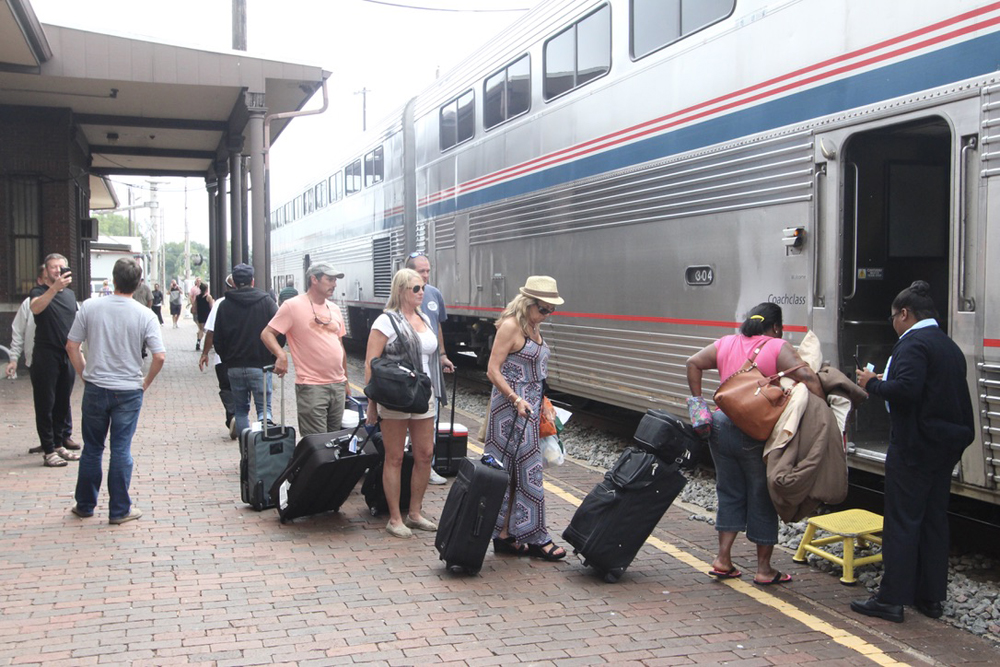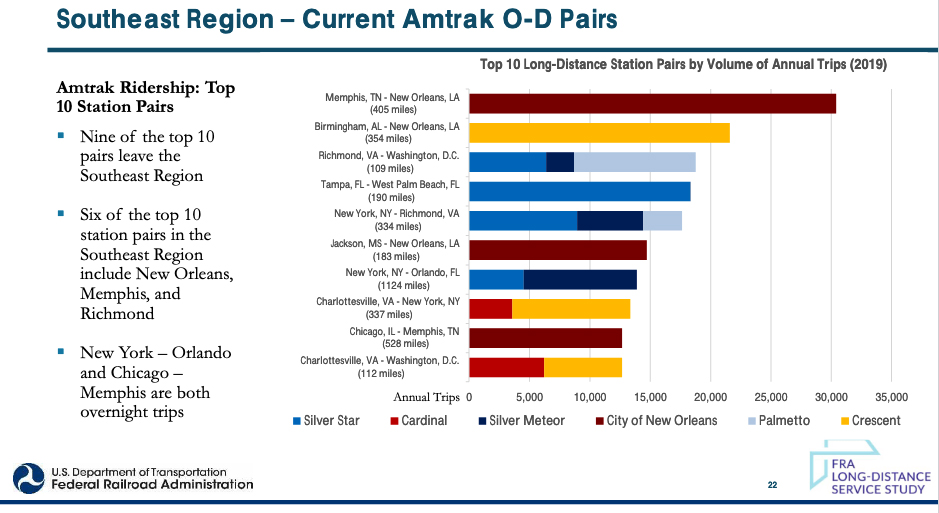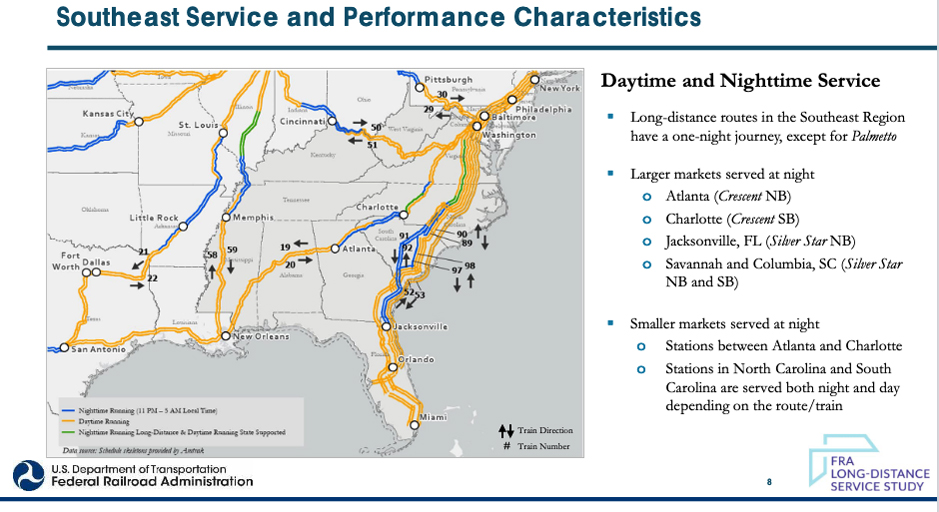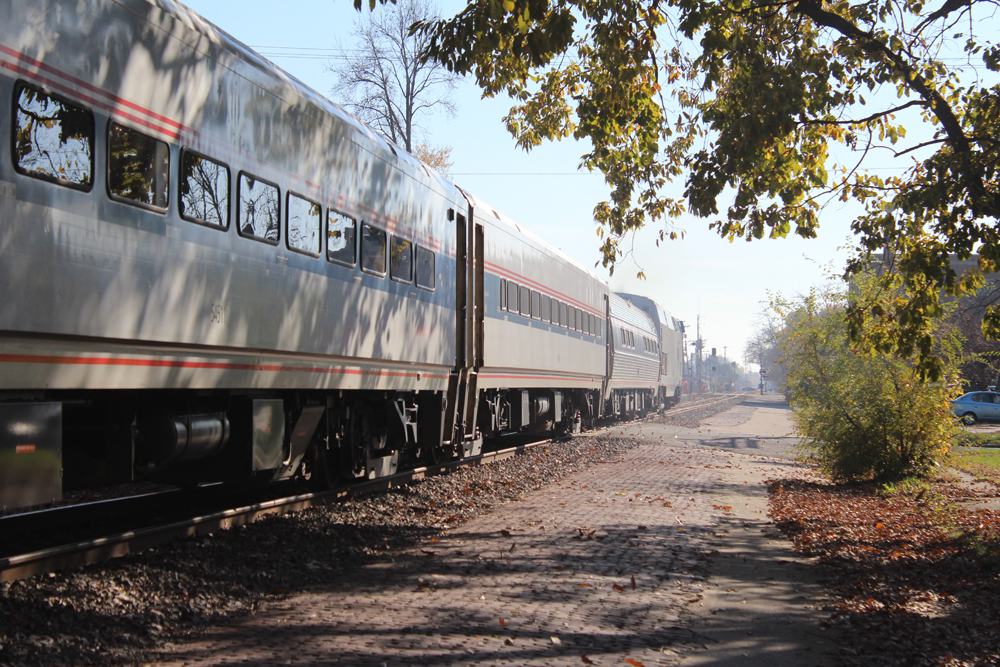
WASHINGTON — The Federal Railroad Administration has published a surprisingly detailed summary of regional forums held during the past month in which the agency solicited opinions regarding the public’s interest in strengthening Amtrak’s national network.
As part of Amtrak’s reauthorization, 2021’s Infrastructure Investment and Jobs Act tasked the FRA to conduct a study that would evaluate restoring previously discontinued long-distance routes; establishing new service to cities not currently served by Amtrak; and converting the triweekly Cardinal and Sunset Limited to daily operation.
In materials shared with those attending six regional meetings held in Washington, Chicago, Denver, and Jackson, Miss., the agency went a step further by first dissecting ridership of Amtrak’s existing long-distance trains operating in each region. Those PowerPoint presentations, and suggestions offered by attendees, are now available at the FRA’s “Long-distance service study” website.
Using 2019 data, the wealth of information revealed about Amtrak service within each region includes:
— Distribution of trip length by distance for both coach and sleeping-car passengers;
— The top 10 boarding stations by class;
— Top connection stations;
— Larger and smaller markets served at night, by train and direction of travel;
— Customer on-time performance by train;
— The top 10 station pairs involving a region’s stations, by volume of annual trips;
— The top 10 station pairs involving or between small communities.
(Story continues below)


Interestingly, Greenwood, Miss., on the City of New Orleans route, accounts for 8,100 annual trips spread among three destinations: Chicago, New Orleans, and Homewood, Ill.
The FRA materials also take a stab at measuring travel potential between city pairs, whether or not Amtrak currently operates any trains serving them. For instance, the Southeast presentation reveals a preponderance of north-south automobile travel from nearby states into Florida.
The “mural exercise” section within each region reproduces what is characterized as a “Brainstorming and discussion of routes, service changes, and markets” that took place in response of the information that the agency furnished. One of the suggestions in the Southeast was extending the daytime Palmetto from its current endpoint of Savannah, Ga., through Jacksonville to Orlando and Tampa, Fla., as a means of capturing more travelers. During the 1990s, Amtrak did exactly that by creating the Silver Palm, a train that once also served Miami. The Silver Star was rerouted to include Tampa when the Palm was cut back to Savannah (as the Palmetto) in a cost-cutting move.
It remains to be seen how the FRA will translate working group suggestions into a meaningful action plan that prioritizes preferred investments. At this stage, there was no analysis of track conditions on potential routes or the willingness of railroads to participate. Except for BNSF Railway, each of the six Class I hosts of Amtrak trains participated in at least one of the six sessions.
The agency is accepting feedback no later than March 17, 2023 (at contactus@fralongdistancerailstudy.org ) before it develops a short list of routes in the spring, prioritizes them this summer, and develops “final recommended actions” in the fall. What happens after that is unclear, given the fact that there is no funding specifically devoted to resurrecting a long-distance route.
Since the Passenger Rail Investment and Improvement Act of 2008 created the 750-mile demarcation between short- and long-distance service, Amtrak management has taken the position that it was not free to add or subtract from the 15 long-distance trains running when that legislation was enacted. The fact that Congress asked the FRA to conduct the study indicates that lawmakers are not necessarily satisfied with the status quo.
Though Trains News Wire will continue to analyze each region’s presentations and working group comments, one national statistic stands out: 62% of passengers on long-distance trains travel 400 miles or less. There is no reason those passengers should be treated any differently than travelers riding state-supported or Northeast Corridor service.














If Amtrak were allowed to use non-U.S. (new or used) rolling stock, they could quickly gain enough spare equipment to allow for expanded service & longer consists, system wide. Once they acquire enough brand new rolling stock from U.S. manufacturers, they could then re-sell those outsourced coaches to some other “third world” entity.
Brightline West has purchased land for a new Las Vegas passenger station at the junction of I-15 and the formerly named McCarran Airport, since re-named Harry Reid International Airport. About 120 miles of new right-of-way tracks would, if built, complete a pathway for a new passenger train connecting Las Vegas & Phoenix. Which utilizes existing PHX-Parker rail tracks, +new 40 miles via Lake Havasu City to Topock, +existing 12m BNSF to Needles, +new 80 miles to Boulder City, NV. Then existing tracks to LV. And: hopefully be able to have access to the same new Brightline West passenger train station, whether the LV-PHX line is operated by Brightline West, Amtrak, or some other entity.
The Sunset Limited could maybe gain ridership by simply shifting the schedule by 12 hours on alternate days. Westbound train to Houston, arrive at 11:00 PM on Monday, Wednesday & Friday; arrive at 11:00 AM on the other 4 days of the week. May require more new or refurbished train cars to do so, however.
Midwest to Florida would work best if there were feeder trains from Louisville, CHI / IND, 3 C corridor. and Huntington to connect to a train from Cincinnati thru Atlanta. Atlanta as the largest % increase of the MSA population growth of any other cities. Nashville, BHM, and Montgomery served by regionals to Atlanta or just connect at Chattanooga.
Best Chicago to Florida route would be the old Dixieland Route. Chicago, Evansville, Nashville, Chattanooga, Atlanta, Jacksonville.
Amtrak looked at it in 92 and said the proposed train would go on NS from Dalton to Vienna, GA to serve the current Atlanta Station.
That being said, this is all pie in the sky. Until Amtrak gets its current trains expanded and operating reliable, expansion of routes is a pipe dream.
What a surprise, the Southern LD trains have the highest ridership between the city pairs served during normal daytime hours. Living between ATL and CLT on the Crescent route, it’s difficult to get interested in catching the train in the middle of the night going either direction.
Jim Giblin, the CITY OF MIAMI route (IC/SOU/SCL) is no longer available due to abandonments. The SOUTH WIND route (CSX thru Indy-Nashville-Birmingham-Montgomery-Jacksonville) might be doable with some investment.
My favorite Midwest to Florida train would be Chicago to Atlanta via NS. Run the train only in the winter months when we know the travel market is there. Also, you have excess Superliner cars from the summer service. Use existing stations in Chicago, South Bend and Cincinnati. Connect other Midwest cities to the train with Thruway bus service. At Cincinnati lock the train up with no more stops util Atlanta. It would be in effect another unit train on the NS.
What do you think about a second train New York to Chicago on the old schedule in the summer and use the trainset NYP to Tampa as as second section of the meteor in the winter ?
How come no mention of the Texas Eagle? Is it being eliminated? There is no Sightseer Lounge on this long distance train. I was on the train when it was eliminated. That was a horrible trip from St. Louis to San Antonio. The Cafe food is horrible, and they ran out!! This doesn’t make any sense.
For every one of the well-thought-out submissions from someone like Carl Fowler, I bet there will be thousands of wingnut “I just want my train” suggestions from anyone who can access the Internet. My guess is that the blizzard of input will likely mean that any logical, fact-based contributions will be buried and never seen, or not seen by anyone who can actually affect change.
The salient point here is that there are A LOT of possible new routes, but money is really limited. If any has knowledge of how big the available pot might be for infrastructure to create new routes, I’d like to know what it is. I’ve heard the a number as low as $2.4 billion, which seems logical. Many are starstruck with the total $66 billion number, but much of that will go to infrastructure in the Northeast Corridor. Assuming the $2.4 billion to be the amount, past studies for a North Coast Hiawatha and Pioneer indicate that each of these trains would each suck up about two-thirds of that amount. And a Floridian would cost much more, including a common station in Atlanta to serve the Crescent.
Obviously, the main goal should be new equipment for the existing long-distance trains. As it stands, it is completely illogical to fantasize about any new long-distance service when the continued deterioration of available Superliner equipment will likely result in the discontinuance of Western trains before any new rolling stock is available – likely 7 to 10 years off. Amtrak needs to immediately create a refurbishment program.
Once that’s in place, the focus for additional long-distance services (for when new equipment could be available) needs to be on expanding existing routes, such as New York-Chicago via Buffalo, New York-Chicago via Pittsburgh, Montreal/Boston-New York-Florida, and Boston-New York-Atlanta. By adding frequencies, long-distance trains will (finally) achieve the economies of scale they don’t enjoy now (more trains using the same infrastructure and many of the same operating, MOW and station personnel). And it’s also important to remember why significant long-distance services were discontinued in 1979, 1995, and 1997: Trains were added to the system over the years, but Congress wouldn’t appropriate operations funding in perpetuity. The IIJA doesn’t guarantee operations funding forever, just six years, and in diminishing amounts. In contrast, when frequencies on a route are added, patronage usually grows exponentially rather than arithmetically. Therefore, additional trains accompanying the Lake Shore Limited or Silver Meteor could create new revenue which may cover their operating costs. Adding new frequencies to existing routes is not only the most cost-effective way to spend the money, but it is the least risky in the long run, and will help establish long-distance trains as needed and used transportation in the daily lives of the people in the communities along the routes, something that is less likely for a route with one train per day (or less).
The worse possible scenario would be spending billions on a single route only to have operations funding for it (or another route) pulled in the not-too-distant future, surely ending any possibility of additional funding for long-distance trains – ever.
Mr. Meyer, you hit it too! You are right on the money with expanding frequencies on the EXISTING LD routes before opening new ones. The Lake Shore is my case in point. One NY-CHI with a BOS connection, one BOS-CHI with a NY connection on complimentary schedules is my suggestion. Yes there will be the issue of what happens, as an example, with the BOS connection when the CHI-NY is 2,3, or 4 hours late. Also to the NY connection, if it is a regularly scheduled Empire Corridor train, with the BOS-CHI is in a similar delay.
I made this submission today to the public feedback link on the USDOT/FRA study of expanding Amtrak’s national (long-distance) route network. As the Newswire notes you can submit your views at the embedded link as well.
*************************************************************
I speak from intense personal experience about Amtrak’s long distance national network trains. Not only have I ridden the entire Amtrak route network, but from 1983-2017 I worked full-time helping to sell it through my rail specialist travel and tour company Rail Travel Center/RTC. There is so much to cover here.
First on the question of expansion:
All Amtrak routes should be served daily and efforts should be made to correct the predominate east-west nature of much of the system off the east and west coasts. We repeatedly surveyed our customers at RTC and they asked consistently over a thirty year period (more than for any other unserved routes) for direct trains from Chicago to Florida via Atlanta and from Denver to Texas via Colorado Springs, Fort Worth and Dallas. The next most requested routes were direct options from Denver to Los Angeles, Seattle/Portland and Kansas City and for the return of the former Northern Pacific route from St. Paul to Seattle via Billings and Missoula and for the overnight MONTREALER from DC to Vermont and Montreal.
But the long distance network both now and in the future is most constrained by actions taken by Amtrak’s own management to contain costs at the expense of ridership and repeat patronage. These are as important (if not more so) to rectify as the need to add services. Left unaddressed the national network will continue to fall far short of its potential.
Amtrak routinely does not provide the cars on its trains to meet the demand which is on offer on its national network. Excuses vary, but the evidence is graphic.
How can the company possibly justify running on the DC/Chicago CAPITOL LIMITED only one coach and one sleeper (plus a diner-lounge car whose seating area is off limits to passengers riding in coach–who must take all food/beverages back to their seats)? This train traditionally carried three coaches and two sleepers.
The EMPIRE BUILDER offers only one coach from its western terminus, Seattle to Chicago, even though for decades the train sold out at least two and often three coaches from there. The extra seasonal second sleeper has vanished as well. Even though frequently the train was sold-out, this capacity was not expanded last year in the summer or over Thanksgiving and/or the Christmas/New Year’s holidays.
Across the system Amtrak artificially constrains capacity to save staffing and car maintenance costs. The long-distance network has seen trains like the TEXAS EAGLE downgraded by requiring even sleeping car riders paying over $1000 for rooms to be subjected to “enjoying” a diner with only reheated food (which coach riders can not sit down in at all–nor eat anything but snack take-out) and the lounge car is banished entirely. A coach passenger traveling the full route of this train from Chicago to San Antonio faces four meal cycles southbound and five northbound with only a take-out snack meal offering. But this saves Amtrak from having to perform a mandatory brake service on the lounge cars and saves paying another waiter in the diner.
How does Amtrak justify asking coach passengers on its long-distance trains to accept being banned from the dining car and condemned to sandwiches/microwaved pizza for up to three days enroute–when railway diners served all riders for 150 years? How does Amtrak justify shrinking the consist on every long distance train despite the highest appropriations for its national network in its 52 year history?
The answer is institutionalized pessimism. The company is afraid to innovate, to be pro-active, to assume things will get better if the service is better. Instead it relies on the worst old-time rail operating department philosophy, summed up to me once by the Southern Ry’s late Jim Bistline (who did not approve) as–“get that damned train over the railroad” even if no one uses it.
The company’s petty cost-cutting has extended to denying prospective riders access to even pdf copies of its timetables. For a saving of a few cents per rider Amtrak has made it almost impossible for the average prospective passenger to gain a broad view of the carrier’s service choices and options. How in particular does an inexperienced Amtrak rider learn that there are multiple route choices for direct trains from Chicago to New York and Washington? A cursory view of a computer reservation screen does not help. All you see is origin/destination without digging deep into a very poorly designed website.
The future of the long-distance network requires not only daily service, more trains and new routes. It requires capacity, marketing, quality on-board service and adjustments to reach seasonal demand peaks. It is highly relevant to note that Amtrak can not be bothered to take waitlist requests on its frequently sold-out trains, presumably because someone would have to staff the follow-up to call prospective riders when/if space cleared. But by so doing the company also denies itself any real sense of how much potential ridership was not served. If the company knew it had 70% of the capacity of an extra sleeper ready to book a month before departure how could it turn that income away?
I applaud this study and hope it points the way to Amtrak’s expansion system-wide. But dreams will not translate into patronage unless Amtrak is forced to change its corporate culture from one of entrenched and often petty pessimism and cost-cutting to one that seeks ridership growth and understands the need to provide comfort, capacity and good customer service on all trains.
Amtrak must use its new equipment funding for the national network’s 21st century fleet not only to replace present car numbers in kind, but to build a reserve fleet as well.
And it must rediscover route-specific marketing for the long-haul system–not merely (rare) advertisements that note that trains exist. To fill those trains the pubic must know where the trains go, how good the experience of riding them would be and then be able to get confirmed space when they decide to ride because Amtrak runs enough cars to meet the demand that is at hand!
Mr. Fowler, your commentary regarding the outlook of the current top management at Amtrak and your citations of the ways in which they have been swinging a wrecking ball to the long-distance trains starting with Richard Anderson’s tenure as CEO in 2018 is one of the best, if not THE best and comprehensive I have read. But will any at the FRA team facilitating this study listen to you? And if they do what actions will they take? Certainly, nothing short of the dismissal of everyone at the top, including and especially, Stephen Gardner and Board Chair Anthony Coscia will do. That action is the only way to make way for the change you (and most readers here) seek. My confidence level that FRA will run with that and go to Congress and the administration with that plan is ZERO.
CARL — Great post! Telling the truth gets you nowhere in this country, but even so it’s your duty.
Mr. Fowler, please send your treatise to the head honchos at RPA who are so tight with Amtrak’s top managers that they refer to Anthony Coscia as “Tony” and Stephen Gardner as “Steve”. James Mathews and his top lieutenants need to read this.
While the Auto-Train is popular amongst a select group of travelers and serves a popular tourist and vacation area, the vast majority of folks would rather hop on a plane and once they reach the airport, rent a car for the duration of their stay. Or the other travel option is driving down to Florida. A lot of people rent or own campers which they use as their traveling home while driving to their destination. Besides the two terminals of the Auto-Train are located in surburban areas away from the main city hubs and still requires some driving just to get to the train. Most folks would rather drive the whole distance or fly. People like to travel directly to their destination and avoid all the in between stops and transfers. One other factor to consider and this goes for all the long distance trains Only one daily train in each direction is not going to make a profit for Amtrak and also not going to attract a larger share of the traveling public. You also need better connections and transfer points between connecting trains and better times as well.
Joseph C. Markfelder
“Only one train in each direction is going to…attract a larger share of the traveling public”. That’s it for the LD trains. They either have to operate twice daily AT A MINIMUM or maybe we should just let them go. And that’s true as well for the daytime medium-distance trains like the Ethan Allen and the Adirondack (if NYState and Amtrak ever deign to bring the latter back).
There is a lot of info in the presentations on the website. Very interesting to see the stakeholder inputs on the “mural board” parts. You can definitely see strong support for returning the 2 triweekly to daily service and support for Chicago to FL via Atlanta. Also interesting to see how they divided up the regions. Any division one chooses will have questions around the boundaries, but the diversity of concerns and interests in the different regions gives me insight that they chose the boundaries pretty well to capture a set of common stakeholder interests.
I saw no mention of Auto-Train. This is a successful service that would be well patronized as a Midwest – Florida route if equipment was acquired and facilities were established. It wouldn’t have to be faster than a second-morning schedule to gain a lot of traffic that currently uses the highway.
Mr. Dupee, I do not think the Midwest has the population or traffic density to support successful Florida service. On the East Coast everything and everyone uses the I-95 Corridor. Here in the Midwest, we have at least three surface corridors running from the Great Lakes to Florida. These are via I-75, I-69/I-65 and I-57. Before Amtrak (once upon a time) we had Midwest to Florida trains running on the Southern, the C&EI/L&N, PRR/L&N and Illinois Central. Which route would you select for a successful Florida service?
Midwest-to-FLA auto train. I salivate at the prospect.
The original AutoTrain company, before AMTRAK took the service over, did have a Midwest-Florida autotrain. However, it failed miserably.
A long distance train from the Midwest to Florida might be needed and would probably be popular.
There was one, the Floridian, which was dropped as part of the major cuts of 1979. However, it was probably doomed from the start because of the abysmal condition of the Penn Central tracks.
CHRIS —- Can’t argue the need or the popularity, only the reality out on the railroad. CSX tracks Nashville to Atlanta can’t support passenger traffic at anything faster than a crawl. Nashville reminds me of my own state capital, which is Madison. Both cities are prosperous, growing trifectas of business, state government and education. The need for passenger trains in both cities is obvious. Getting a train there is dodgy. Columbus, Ohio’s biggest city, is in many ways similar.
What Amtrak discovered with The Floridian (James Shigley post below) is that the distance was too great for a train too slow.